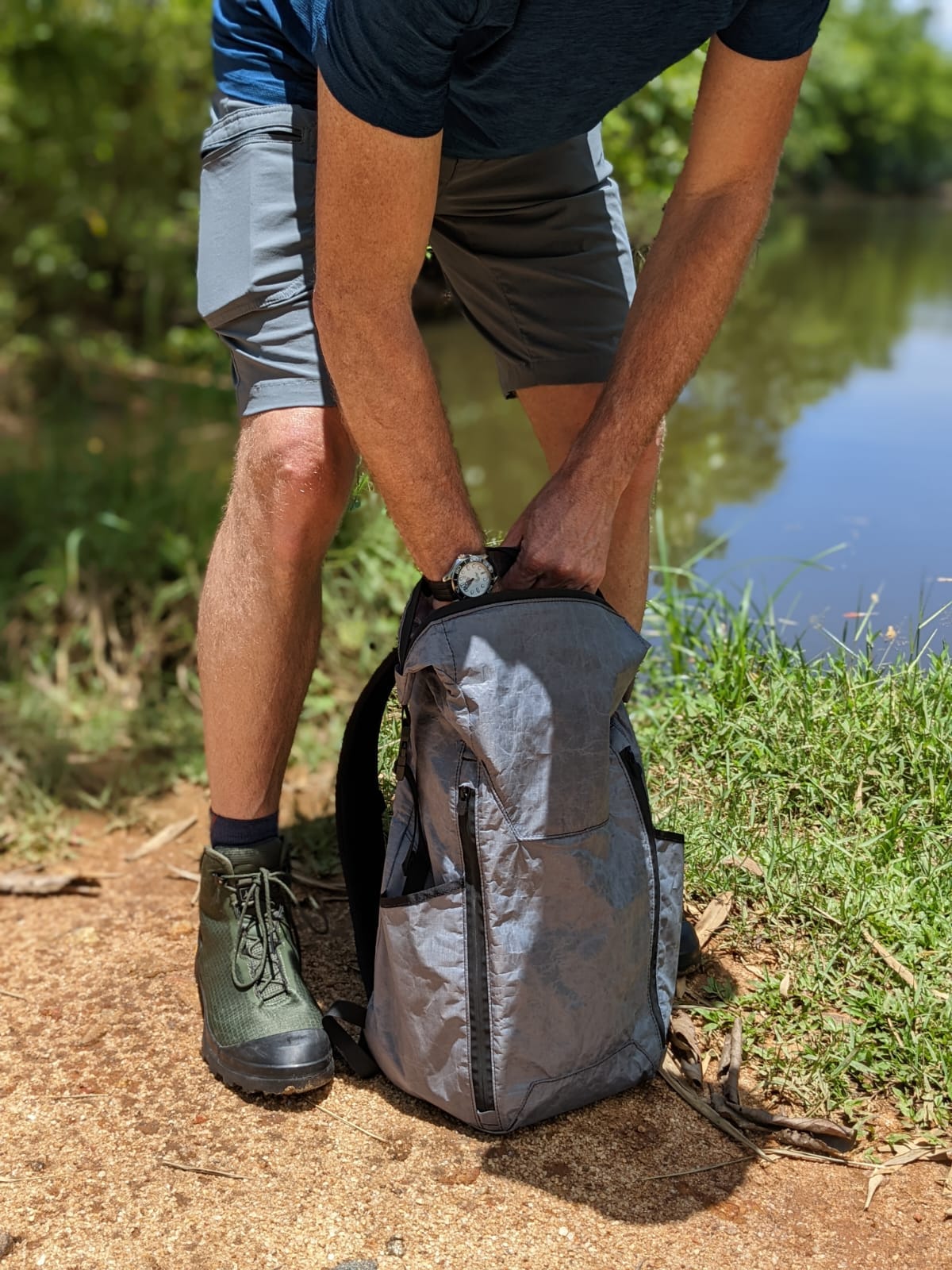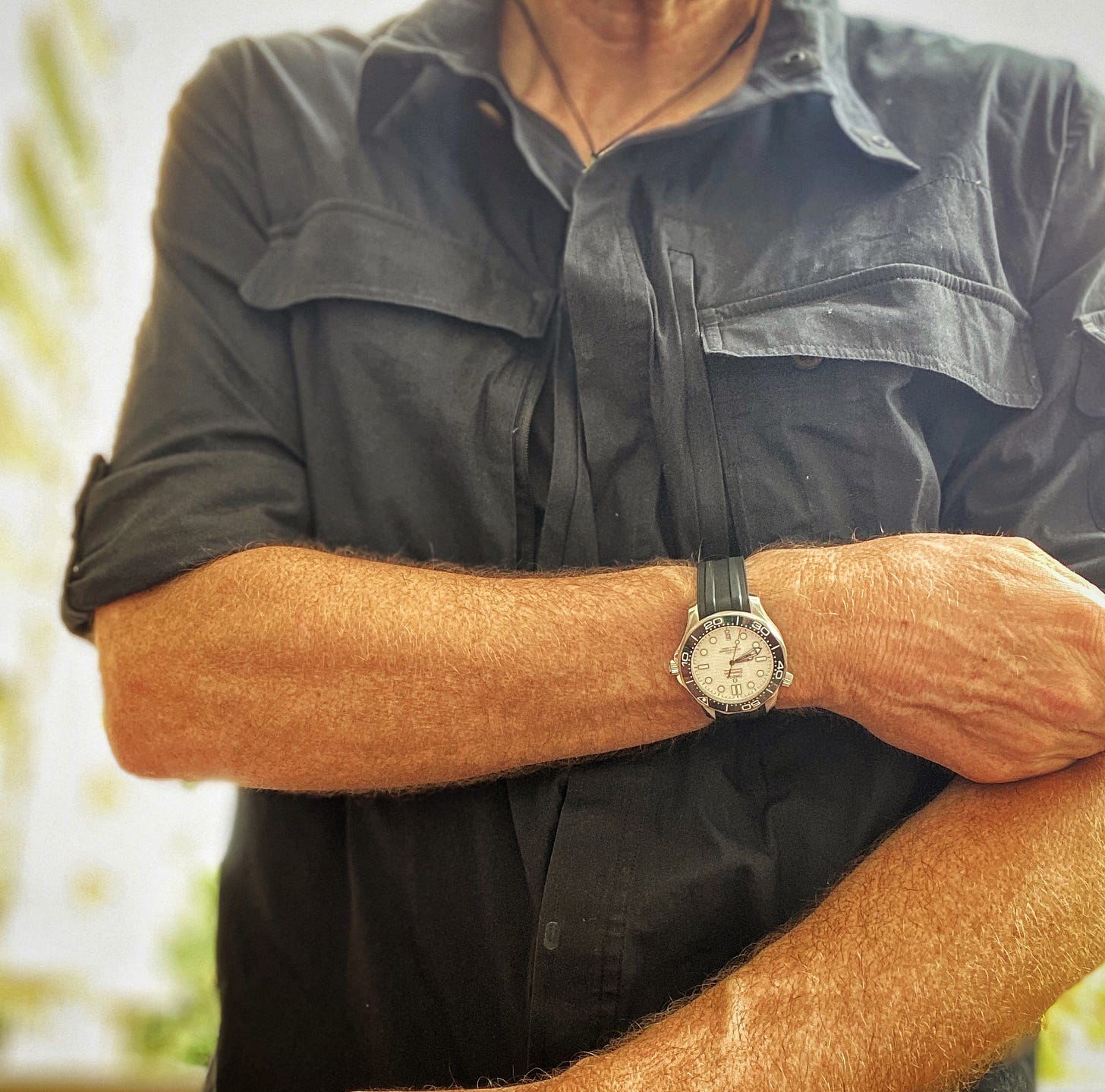As it happens, I would have done fine with just one watch during my month in Sri Lanka. In fact, I had full intentions to just wear one and then, per my usual custom, pack along a spare, just in case (dropped, stolen, magnetized, lost to the depths due to a broken spring bar). In essence, that’s what I did—I traveled with my beloved Omega on wrist, and had my CWC Royal Navy diver tucked safely in my carry-on bag. But then, at the last minute, I stashed an old Seiko diver into my dopp kit because, well, Seikos just go hand in hand with the tropics (see: Willard, Captain). And then my watch loving wife also brought two watches, wearing my (OK, her) Blancpain Bathyscaphe and packing the Tornek-Rayville TR-660. So yeah, it was an embarrassment of riches, horologically speaking, and not exactly the minimalist philosophy I was hoping to embody. In the end, however, I enjoyed the variety and wound up learning a few things about my watches and myself.
After a winter wearing my white dial “Arctic Bond” Omega Seamaster almost nonstop—skiing, running, ice diving—it seemed natural to just keep wearing it. It’s comfortable, tough, handsome, and versatile enough for the variety of activities we’d planned for our time in Sri Lanka. In terms of wrist time, I wore the Omega perhaps 50% of the month, for activities ranging from swimming laps in our apartment’s outdoor pool to dawn runs around the nearby rice paddies to snorkeling the south coast.
If there ever was a candidate for a “one watch,” this is it, at least for me. If you’d asked me a year ago, I’d have said my Rolex Submariner would fit that bill, but the stigma and worldwide recognition of Rolex are liabilities, at least in my opinion. To be clear, the Omega is also a luxury watch, and wearing it to a country whose per capita income is almost exactly the retail price of the Seamaster feels a little tone deaf (I’ve never felt threatened by physical confrontation or theft in Sri Lanka, in case you’re wondering). But somehow, a white dial Omega on a rubber strap seems a little less ostentatious and recognizable than a Sub on a steel bracelet. At least that’s what I was telling myself.
I kept the Seamaster mounted on its OEM rubber strap but brought along a spare set of spring bars, a tool, and a couple of nylon NATO straps for alternatives, though I never ended up switching. I have mixed feelings about rubber straps. On the one hand, they look perfect on dive watches, keeping things decidedly casual while being ideal for waterborne activities. But in hot climates, they can be clammy, trapping sweat against the skin and chafing. But I’d had experience with this Omega rubber on a black-dial loaner I took diving in Bonaire for a week back in 2019. The supple rubber, combined with the textured back, make it extremely comfortable in the heat. That held true over a month of sweltering weather, made worse by daily power interruptions that immobilized ceiling fans and air conditioners. And, unlike NATOs, which get soggy, or bracelets, which are heavy and rattle around when you do anything fast paced, the rubber was the perfect choice.
When you travel, the best thing you can say about your gear is that it disappears. It doesn’t distract from your adventures, nor does it keep you preoccupied by malfunction, discomfort, or its preciousness. The Omega did just that. It performed flawlessly, keeping accurate to within a couple seconds a day, was comfortable, and looked good on my increasingly sun tanned wrist every time I had occasion to check the time. It also felt just right, in a vaguely Bond-esque way as I moved from airport lounge to city to mountains to beach, and from polo shirt to swim trunks. Although the ceramic bezel will never scratch or fade, and the dial markers and hands will never age to a café au lait tone, the steel case and edge of the bezel picked up a few scratches, of which I am quite proud. This watch continues to collect memories and become even more my own.
I didn’t really expect to change watches much, but in our second week in Sri Lanka, the Tornek-Rayville caught my fancy and I strapped it on for a trip to a private island in the middle of crocodile-infested Bolgoda Lake, south of the capital, Colombo. Like the Omega, the TR-660 is a versatile travel watch, perhaps even better suited for a tropical sojourn to a developing country. With its smaller profile, spare black dial and entirely matte grey case, it is both eye-catching and nondescript at the same time. Even the name and dial markings are almost industrial: name, rank, country of origin. At ease, soldier. On the olive drab NATO strap it feels decidedly suited for jungle maneuvers. The Seiko movement ticking inside is legendary for its ruggedness if not its accuracy, but then Bill Yao at T-R has adjusted it for a precision I’ve found almost rivals that of the Omega. I’m usually a fan of no-date watches, but in the case of a month abroad and ten and half hours off my home time zone, I found I wanted to check the date regularly, The lack of that function was the only thing that would keep the Tornek from a short list of perfect long term travel watches. But as a rough and ready backup adventure watch, it fits the bill.
In the end, I might as well have not brought the Seiko. I only wore it a few hours total, for swimming laps one day, a morning run another, and not much more. For one thing, it’s an old watch—a 1980s reference 7002J with a red and blue bezel. But its uneven accuracy, chafing rubber strap, stiff bezel action, and lackluster old lume meant that it never lasted long on my wrist in Sri Lanka. I actually contemplated giving it to someone there as a gift if the opportunity arose, but it didn’t. So it came back home with me. And that’s OK. Watches don’t take up much room in the luggage anyway and a backup Seiko is a low risk proposition.
The watch that rivaled my Omega for the most wrist time in Sri Lanka was my CWC. I could (and have, and will again) write an entire article about my love for Cabot Watch Company’s timepieces. They tick every box for me—unpretentious, classic good looks, affordable, and legendarily rugged, with military pedigree. They also have one of the most perfect case shapes of any diver, and a dial design both functional and visually appealing, drawn from the same Ministry of Defence specification that spawned (or was inspired by, depending on whom you ask) the Omega Seamaster 300.
On a previous trip to Sri Lanka, I brought a CWC Royal Navy diver and wore it, fittingly, to dive a sunken World War II warship. That one was a 1995 issued quartz watch. This time I brought a 2004 vintage automatic version with a date function. These watches feature welded strap bars, meaning you can only wear them on one-piece straps; i.e., NATOs. This is an advantage when traveling, since there’s zero concern of a broken strap or bar where repair or replacement could be difficult or, worse, the watch is lost. For variety, I simply stuffed a handful of ribbed NATOs into my bag—blue, mustard (curry?) yellow, and grey, and swapped them out after swimming, showering or sweaty runs.
Like the Tornek-Rayville, the CWC has that non-nonsense “grey man” anonymity and utility that works so well in unknown or sketchy environs. There’s also a handsomeness to it that is unlike that of the pretty boy Omega—Daniel Craig versus Pierce Brosnan, if you will. I wore this watch a lot, daily for stretches at a time, for running, swimming and an epic adventure hiking in the mountains of Sri Lanka’s central tea country. It was firmly strapped on my wrist while we bushwhacked through jungle populated with killer hornets, wild boar, and venomous snakes and, while I don’t recall checking the time once during that adventure, it also was an unobtrusive and faithful companion. Wearing it now in the comfort of my home office, it reminds me of that day, an accessory to that indelible memory.
As I wore each of the watches during my trip, I thought to myself that any one of them would have been sufficient on its own. I found that I didn’t crave variety, of any sort really. I wore the same three shirts, two pairs of shorts, and boonie hat, for the whole month, doing laundry regularly and drying it all in the hot, tropical sun. I ate roughly the same meal twice a day (curry) and relished the simplicity of it all while soaking in all that is so different about Sri Lanka. It’s the same feeling I get when I return home from a backpacking trip: I lived for days on what I could carry. Why do I need all this other stuff? I started mulling a major sell-off of watches, donating clothes I don’t wear often, and other general downsizing. A month away, especially in a country like Sri Lanka, reframes your perspective, a valuable exercise for me, and one that was long overdue after a couple of years of pandemic-induced wallowing amidst my stuff.
On the other hand, I grew to appreciate each of the watches I did take, and wear. A tool watch really comes into its own when you’re out in the world living by your wits, doing a variety of physical activities, improvising your days. And now that I’m back home, my respect for, and attachment to, the Omega, the Tornek-Rayville, and the CWC have grown deeper, because they now carry the memories of what was an epic month of rabid dog bites, snake dodging, peak bagging, and ocean swimming. And in that way they’ve each done the most important job a watch can do: keeping the time of our lives.










Great read. Hope you compile these into a book someday. BTW, you still plan on giving away that Seiko? I’ll buy it from you.
Excellent.
I have to say, throughout much of your writing, that CWC runs as a single gilded thread. It embodies your ethos to a tee: jaunty Anglo adventure, ready to splash at any moment, not flashy, but confident and full of spirit.